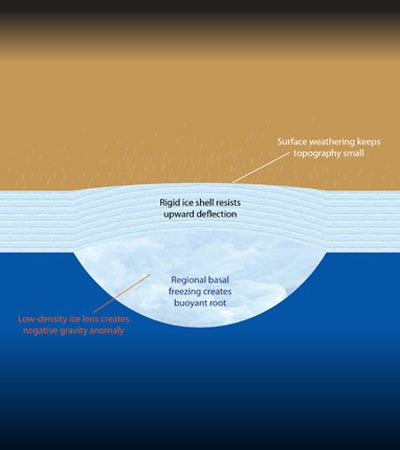Led by Douglas Hemingway and Francis Nimmo from the University of California Santa Cruz (UCSC), the study used new data from NASA’s Cassini spacecraft. The researchers were surprised to find a negative correlation between the gravity and topography signals on Titan.
“Normally, if you fly over a mountain, you expect to see an increase in gravity due to the extra mass of the mountain. On Titan, when you fly over a mountain, the gravity gets lower. That’s a very odd observation,” said Nimmo.
To explain that observation, the researchers developed a model in which each bump in the topography on the surface of Titan is offset by a deeper “root” big enough to overwhelm the gravitational effect of the bump on the surface. The root is like an iceberg extending below the ice shell into the ocean underneath it. “Because ice is lower density than water, you get less gravity when you have a big chunk of ice there than when you have water,” Nimmo said.
An iceberg floating in water is in equilibrium, its buoyancy balancing out its weight. In this model of Titan, however, the roots extending below the ice sheet are so much bigger than the bumps on the surface that their buoyancy is pushing them up against the ice sheet. “It’s like a big beach ball under the ice sheet pushing up on it, and the only way to keep it submerged is if the ice sheet is strong,” said Hemingway from UCSC. “If large roots are the reason for the negative correlation, it means that Titan’s ice shell must have a very thick rigid layer.”
The researchers calculated that, in this model, Titan’s ice shell would have to have a rigid layer at least 25 miles (40 kilometers) thick. Hundreds of meters of surface erosion and deposition are needed to account for the observed imbalance between the large roots and small surface topography. The results from their model are similar to estimates obtained by geomorphologists studying the erosion of impact craters and other features on Titan.
These findings have several implications. For example, a thick rigid ice shell makes it producing ice volcanoes very difficult, which some have proposed to explain certain features seen on the surface.
Unlike Earth’s geologically active crust, Titan’s ice shell isn’t being recycled by convection or plate tectonics. “It’s just sitting there, and weather and erosion are acting on it, moving stuff around and redepositing sediments,” Nimmo said. “It may be like the surface of Earth would be if you turned plate tectonics off.”
The researchers are not sure what could have given rise to Titan’s topographical features with their deep roots. Titan’s eccentric orbit around Saturn generates tides that flex the moon’s surface and creates tidal heating, which could cause variations to develop in the thickness of the ice shell.










